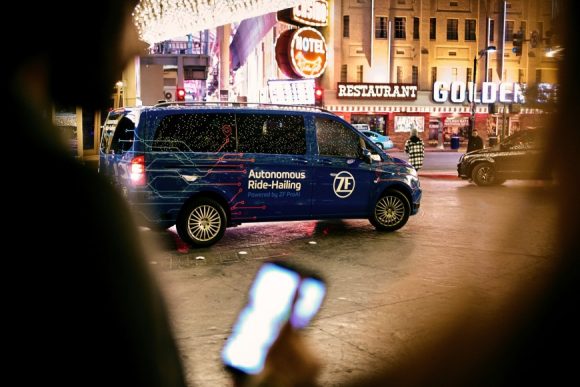ZF will unveil a steering wheel and pedal-free robo-taxi at CES 2019
- Robo-taxi featuring ZF technology at CES 2019 provides a preview of autonomous ride-hailing
- Mobility-as-a-Service is one of the biggest drivers of the development of autonomous driving
- ZF offers automotive systems competence for innovative mobility providers
Friedrichshafen, Germany / Las Vegas, NV, USA, 07-Jan-2019 — /EuropaWire/ — Novel urban mobility choices are one of the biggest drivers behind the development of autonomous driving. A primary example is autonomous ride-hailing, a service based on shared rides in robo-taxis or robo-shuttles. ZF offers extensive systems competence to companies offering Mobility-as-a-Service solutions. It includes radar, camera and LiDAR systems as sensors to help detect the vehicle’s environment, powerful computers such as the ZF ProAI RoboThink with software and algorithms, as well as mechatronic actuators and safety systems. Customers can also benefit from ZF’s ability to intelligently network these systems and integrate them into vehicles. This adds value for customers who want to offer not just vehicles, but mobility services.
At CES 2019, ZF will unveil a steering wheel and pedal-free robo-taxi to show how its technologies enable new forms of urban mobility. Users can hail the taxi using their smartphone or tablet and it will maneuver autonomously to pick them up. It can then chauffeur them to where they wish to go.
“Automation, electrification and networking are critical enablers as the transport of people and goods continually increase in urban centers. With our extensive systems competence, ZF is enabling and shaping next-generation mobility,” said Torsten Gollewski, head of Advanced Engineering at ZF and general manager of Zukunft Ventures GmbH. “Our flexible and modular system solutions are not only attractive for conventional car manufacturers, but also for new companies entering the mobility market.”
Networked systems link vehicles to the cloud
With the robo-taxi, ZF is demonstrating that it can provide the necessary solutions for the development of robo-vehicles and related services. In line with the company’s “see. think. act.” philosophy, the ZF range of sensors helps enable the demo vehicle to precisely detect its surroundings. ZF ProAI RoboThink, the high-performance supercomputer for autonomous driving is designed to process the vast amount of sensor data, translate it into a coherent picture and derive the right commands for the vehicle. These commands are then implemented by connected ZF systems that enable vehicle motion control and enhanced safety – including chassis, drive, steering system, brakes or occupant safety systems.
ZF has also been hard at work networking its intelligent mechanical systems with its cloud-based platform for mobility services. It will be possible to integrate functions across all kinds of providers, for instance for ride-hailing, innovative delivery services and fleet management. The vehicle software can be updated via the cloud.
Cockpit with no steering wheel or pedals
With increasing automation, new concepts for seat positions in fully automated delivery vehicles or robo-taxis are also in demand. The Trendsetting Cockpit from ZF and Faurecia installed in the CES demo vehicle demonstrates where development is heading. It can maneuver without a steering wheel and pedals and is equipped with three screens. Deliverers or passengers can freely choose where to sit. This provides greater flexibility, freedom of movement and new options for interior space utilization.
MEDIA CONTACTS
Florian Stemmler
Technology and Product Communication
+49 7541 77-2367
florian.stemmler@zf.com
Robert Buchmeier
Head of Technology and Product Communications
+49 7541 77-2488
robert.buchmeier@zf.com
SOURCE: ZF Friedrichshafen AG
-
Tweet
-
Share
0 -
+1
-
LinkedIn
0
-
Email
